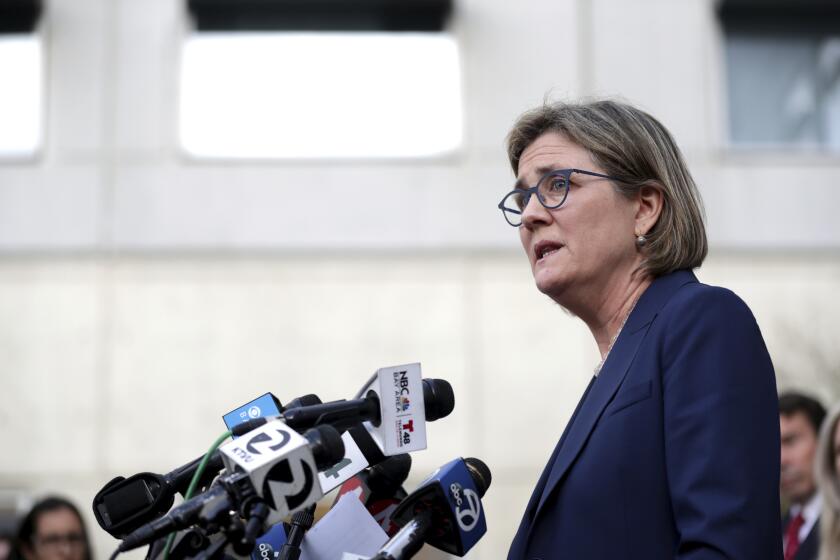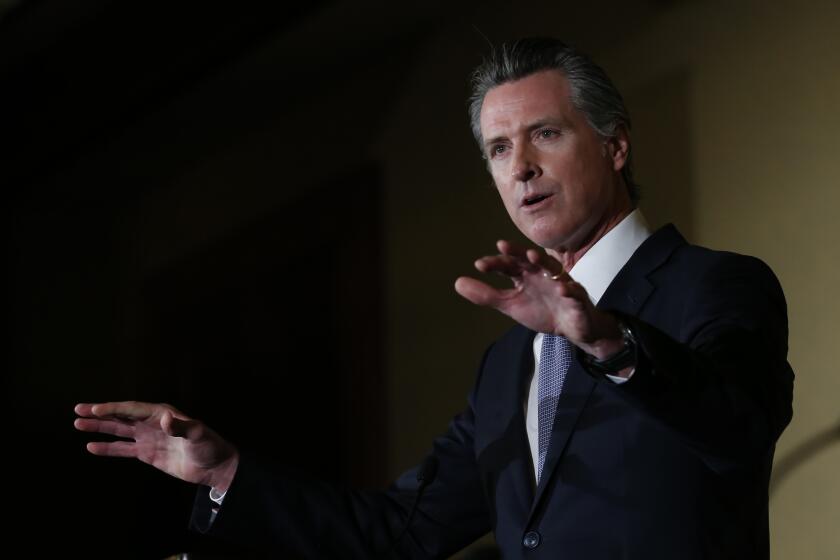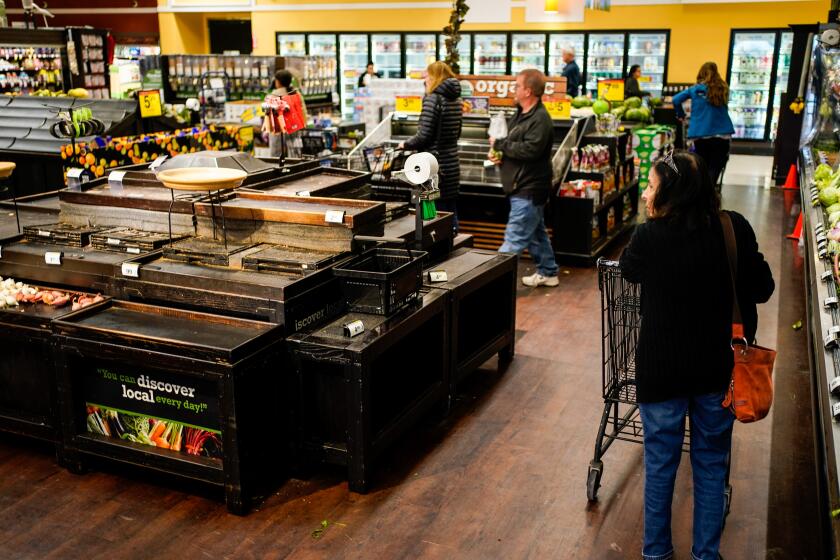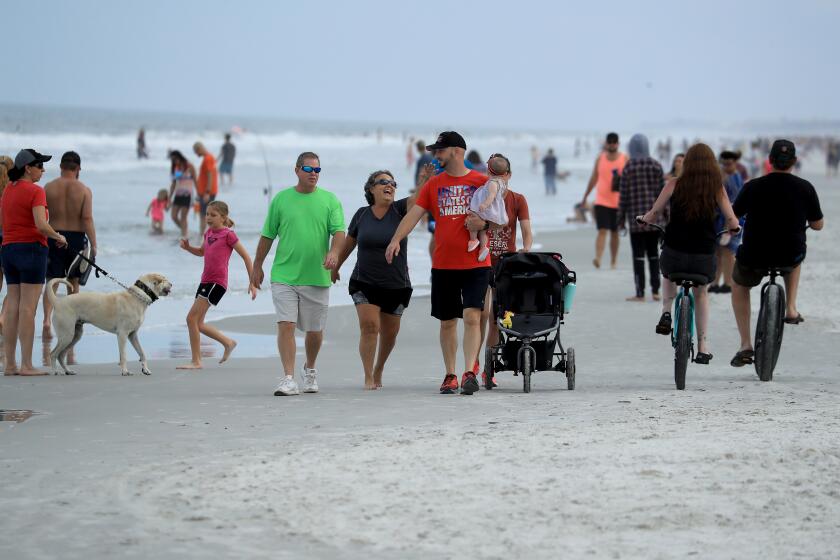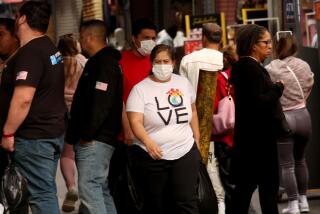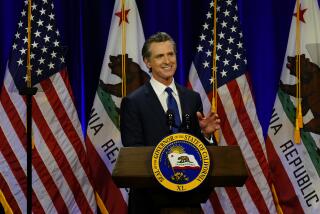Inside Gavin Newsom’s fateful decision to lock down California
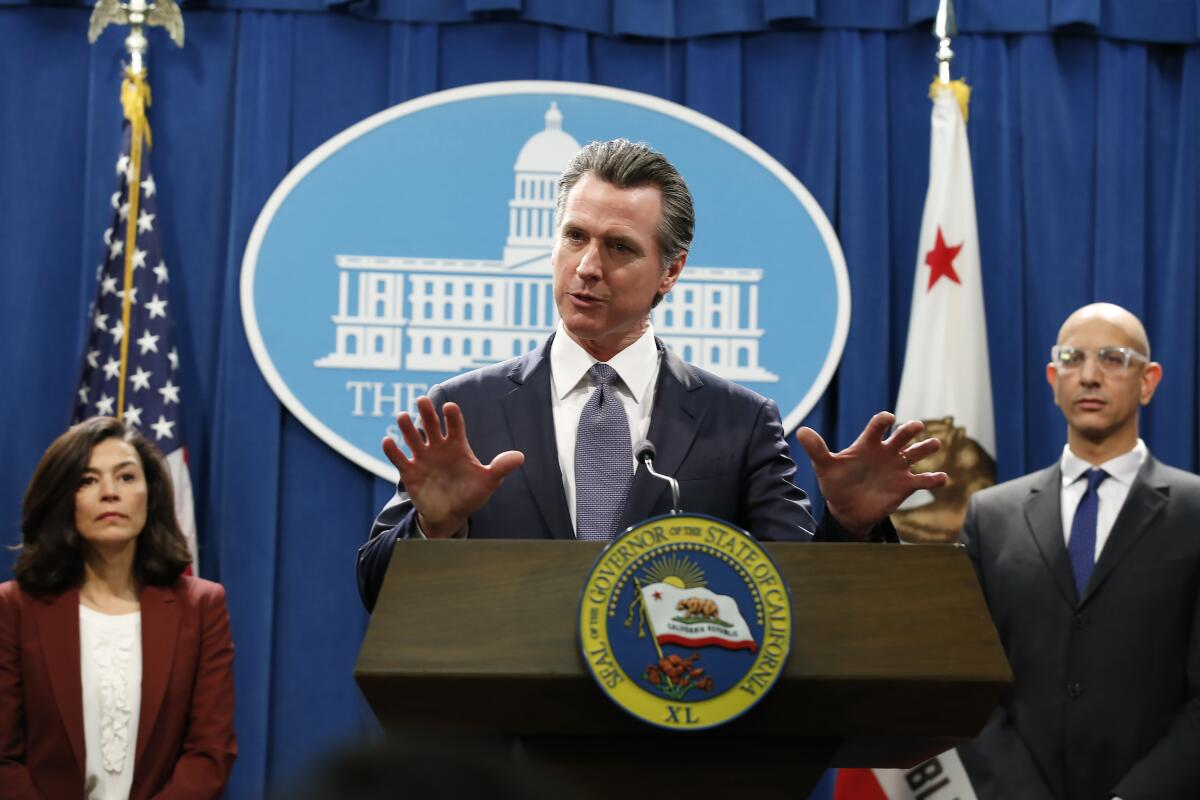
SACRAMENTO — One year ago, in the late afternoon, Gov. Gavin Newsom walked around the second floor of California’s emergency command hub outside Sacramento and into an office where his inner circle of advisors had assembled.
A theater-size screen visible on the ground floor below displayed tallies showing the toll of the coronavirus in the state, at the time just 675 confirmed cases and 16 deaths.
But his administration’s models predicted a catastrophic outcome if the virus spread unabated: More than half of the state’s population could become infected in a matter of months.
Harrowing reports of patients flocking to hospitals were streaming in from New York along with stories about Italian doctors making on-the-spot choices about which patients to treat or leave to die, dire warning signs of a worst-case scenario that could wipe out the state’s fragile public healthcare system unless Newsom took drastic action. And soon.
“He walked in. He didn’t stay. He didn’t sit down. He stood up near the door. He asked me maybe two questions,” said Dr. Mark Ghaly, California’s health and human services secretary, describing his recollection of that moment one year later. “And then he decided, and then he’s like, ‘Let’s go.’”
Hours later, Newsom would stand before news cameras with the busy operations center behind him and announce the most consequential government action in California modern history: All 40 million residents were ordered to shelter in place until further notice.
Effectively shutting down the world’s fifth-largest economy carried enormous political risk and marked a watershed moment for Newsom and California.
In the coming months, the order appeared to be a brilliant stroke as California saw a much less deadly first COVID-19 surge than other parts of the United States. Newsom won national praise, and his leadership was often considered a contrast to President Trump’s.
But the initial stay-at-home order marked just the beginning of an unprecedented health and political crisis that would see Newsom’s decisions increasingly questioned and his popularity wane. The devastating economic toll of the shutdown, combined with a winter wave that made parts of California the national epicenter of the pandemic, saw the state become less of a model.
And now, as Newsom is engineering a rapid reopening of the economy, he faces a likely recall election later this year.
Despite the costs, experts contend that Newsom’s statewide order accomplished the goal he set out to achieve: saving lives by preventing California’s hospital system from being overrun. His first-in-the-nation decision to issue a statewide stay-at-home order set a public health precedent other states would follow.
“It was the right response at the right time,” said Dr. Thomas Tsai, an assistant professor in the Department of Health Policy and Management at the Harvard T.H. Chan School of Public Health. “And it really started the national awareness and conversation about the public health interventions and public policy interventions that were needed at that time to flatten the curve and start our pandemic response.”
Newsom declined multiple interview requests from The Times over the last year, including inquiries to discuss his leadership during the health crisis.
More than a half dozen of Newsom’s current and former aides were interviewed to better understand the events that led up to the decision to implement the historic order. Many of the governor’s staff members were not authorized to speak publicly and requested anonymity for this story.
Their collective memories tell a story of a governor who made the call hours before announcing the order to the public, and of an administration that scrambled to figure out how to craft and implement the sweeping restrictions in the absence of federal leadership.
“Literally, we were creating the California model,” Ghaly said. “Nobody had done something that tried to model out where this was heading and we tried, and we had the CDC on the phone trying to develop it with us. They had not done it. So, I mean, that is just the start of where we ended up kind of trailblazing ourselves.”
Ghaly said his response to the pandemic began quietly in early January 2020. When he returned to work after the holidays, Ghaly’s focus started shifting to conversations with the U.S. Centers for Disease Control and Prevention about the situation in Wuhan, China, and planning for repatriation flights for Americans — the first of which would land in California on Jan. 29.
Newsom’s January calendars show meetings with health executives and the head of BYD Co., the company later awarded a controversial contract to produce millions of protective masks for the state.
But in public Newsom gave no hint if he was aware that COVID-19 was developing into the crisis it would soon become. He took a trip to Miami for the Super Bowl and then traveled to a National Governor’s Assn. meeting in Washington, D.C., on Feb. 7 — the day after the first COVID-19 death in the U.S., in Santa Clara, officials would later learn.
Patricia Dowd of San Jose, who died Feb. 6, was the first known COVID-19 fatality in the U.S.
His annual State of the State address, delivered on Feb. 19, focused almost exclusively on homelessness, which he called “the most pernicious crisis in our midst,” and did not mention the virus.
The calm wouldn’t last. In late February, officials reported the state’s first case of likely community spread in a Solano County resident, the first outward sign of major trouble brewing in California.
“We’re meeting this moment,” Newsom said at his first press conference to address the coronavirus on Feb. 27, seeking to soothe concerns and provide reassurance that the state would be prepared.
Dr. Sonia Angell, who was then serving as California’s public health officer, advised that “the risk to the general public remains low.” Ghaly called it a “rapidly evolving situation.”
In the state, 33 people have been diagnosed with COVID-19, and of those, 24 either were evacuated from a cruise ship or returned on repatriation flights from China.
Within days, the virus was detected on a Princess Cruises passenger ship that traveled to Mexico and returned to San Francisco to unload passengers before departing again for Hawaii, becoming the intense focus of state and media reports.
The governor declared a state of emergency on March 4 and delivered new guidance on activities and events on a near-daily basis.
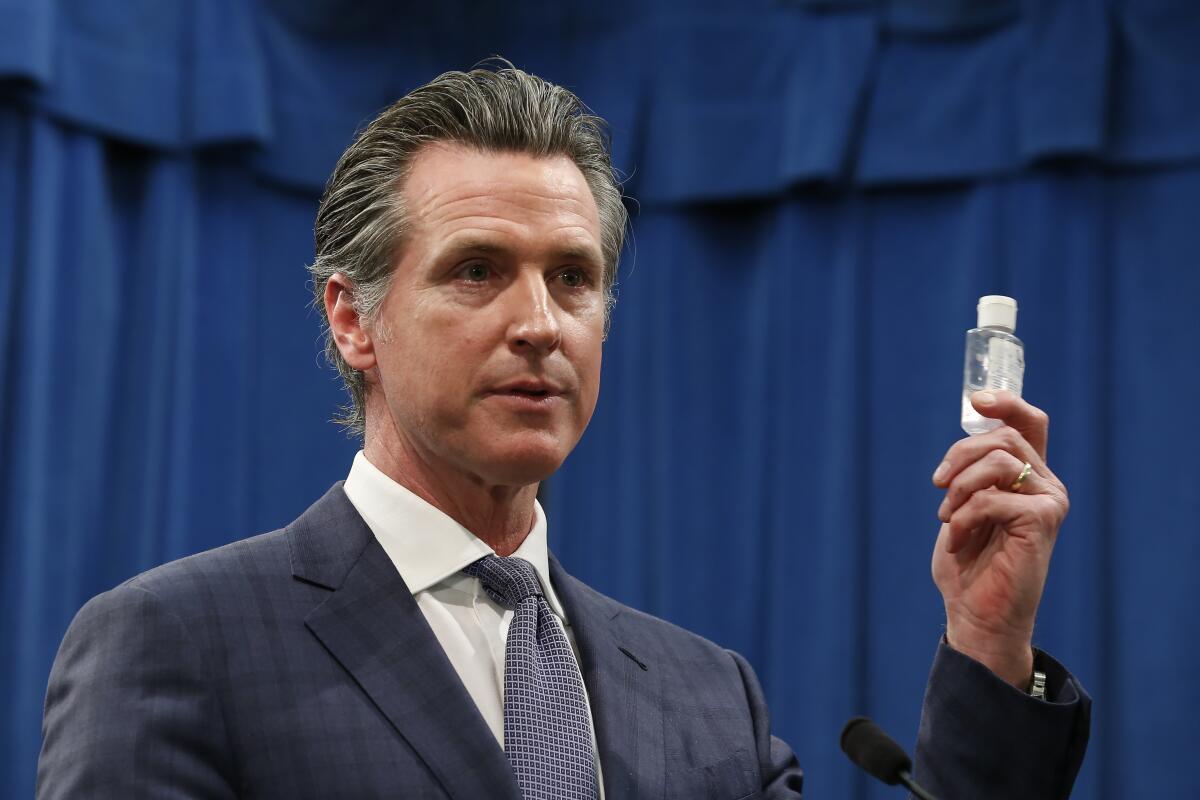
California schools began to close on their own in March, and Newsom followed with guidance on closures and an executive order to ensure schools remained funded. One Newsom aide said the closure of schools marked a pivotal moment and a sign that more would shut down if such an essential activity could be halted.
The governor and his top aides huddled at the state’s emergency operations center on the weekend of March 14, looking at data and details of what was happening in other parts of the world to figure out how to protect California’s most vulnerable residents. They urged Newsom to direct the elderly and vulnerable populations to stay at home, which he announced on March 15.
Coronavirus spread sparks California to request 5.3 million senior citizens to stay home
The next day, seven Bay Area counties joined together to issue a stay-at-home order for all of their residents, and Newsom asked all California restaurants to close their dining rooms, citing the counties’ action as a major impetus behind his decision.
At the time, Newsom and many of his aides didn’t think California was ready for a statewide shutdown, with some counties reporting no cases. But as the days progressed, the data projecting infections, the rate of spread and potential hospitalizations grew steadily worse.
At 2:10 p.m. on March 19, the governor’s office released a letter Newsom had sent to then-President Trump the day before, requesting a U.S. hospital ship to the Port of Los Angeles to help offset the load on the state’s healthcare delivery system.
The governor wrote that new cases in California had climbed 21% in the previous 24 hours and that case rates were doubling every four days in some areas. One warning in the letter sent shock waves through the state: “We project that roughly 56% of our population — 25.5 million people — will be infected with the virus over an 8-week period.”
The number was widely reported by media outlets, inspiring fear and questions about the potential toll of a virus that so far had caused little visible damage in California.
At least one top aide to Newsom said the reaction to that projection helped propel the stay-at-home order, which would be announced roughly four hours after the letter was released to the public. If Californians were as startled as they seemed by the projection, perhaps Newsom and his aides had been a little numb to the data and now was the time to take bolder action, they said.
“My advice was that this was going to be the most decisive action that we could take to make sure that we bought time and didn’t lose control,” Ghaly said. “And that this was likely going to be the hardest path, but also the path that made the most sense to save lives.”
The moment Newsom’s confidants realized California would pull the trigger on the sweeping stay-at-home order is different depending on who describes it, a reflection of various conversations happening in the days and hours prior.
“You could understand it was something momentous and frankly, frightening,” said Lenny Mendonca, who was then Newsom’s chief economic and business advisor. “Unless you’ve been in the middle of a crisis situation where you’re trying to make decisions with incomplete information that have big consequences, it’s hard to articulate. The burden of that decision on an individual is just incredible.”
Newsom’s calendar for March 19 shows a slew of meetings, including a call with his economic advisors, a two-hour morning briefing on the stay-at-home order and another on the “food security supply chain” in the afternoon.
Ann O’Leary, who was then Newsom’s chief of staff, led a briefing at 5 p.m., with the stay-at-home order listed as one of the issues under discussion, according to his calendars.
“At one point, I remember him saying, ‘Is this the right thing to do?’” said Brian Ferguson, a spokesman for the Governor’s Office of Emergency Services. “And the doctors said, ‘Yes.’ And he said, ‘Then we have to do it.’”
Some Newsom aides said their jaws dropped when they learned what they were about to do. Others remember having little immediate reaction. But few had time to process the magnitude of the decision because things were moving so quickly.
Newsom’s staff had only a few hours to prepare for the announcement.
“The conversation at that point and all of our concerns were about public health,” Mendonca said. “But we also had real questions about how to tactically do this, and then concerns about what does that mean for people’s ability to get food, to get around, for school, how do you deal with the fact that a lot of people got their food at school? In your head, you also knew that it was going to have a huge impact on the economy, but that wasn’t the first order of thinking. It was about saving people’s lives.”
Mendonca and others, whose recollection of the chain of events varied, agreed on at least one thing: Once the governor decided that the state would need to order its residents to stay home in the days or weeks ahead, he acted immediately and decisively, rationalizing that it was better to do so too early than too late.
“We had talked about the whole connection to saving lives and the potential of all the lives lost if we didn’t act quickly,” Ghaly said. “We understood also that time was of the essence and that every day mattered. It wasn’t one of those ‘All right, let’s make the decision today and plan for the press conference tomorrow’ situations. We knew it was going to be, you know, as quickly as we could do it, put it in place.”
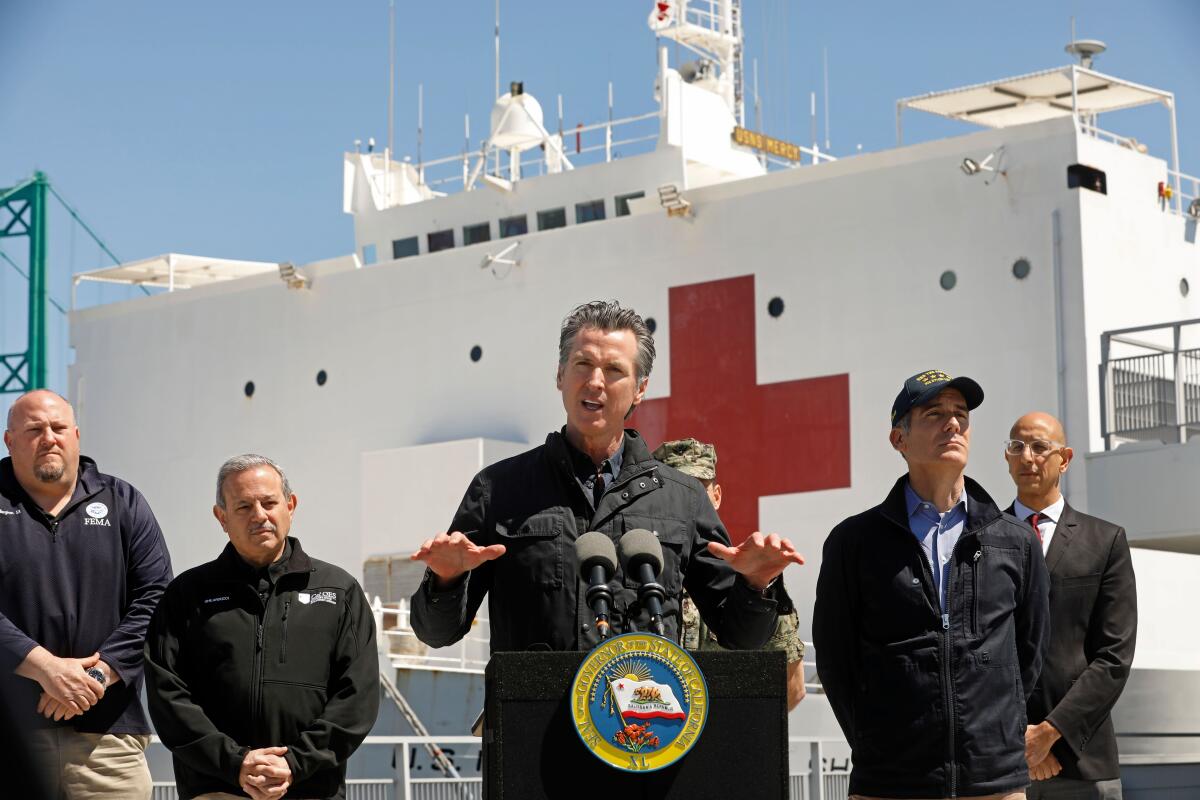
Newsom didn’t come to the decision lightly. His staff knew that as a business owner, he was worried about the impact his order would have on the economy, businesses and workers. California’s unemployment rate would jump from 5.5% in March to 15.5% in April.
Susan Kennedy, a chief of staff to former Gov. Arnold Schwarzenegger and Cabinet secretary for former Gov. Gray Davis, said Newsom didn’t have a choice at that point.
“It was the only move they had,” Kennedy said. ”If you were the public official facing the possibility that a million people could die if you don’t act, there’s nothing to balance.”
At 6:05 p.m. on March 19, Newsom’s press office sent an email to reporters advising a 6:30 p.m. news conference to make a major announcement on the state’s response to the COVID-19 outbreak.
“I have long believed that the future is not just something to experience, it’s something to manifest,” Newsom said from the lectern. “That our fate and future is inside of us. It’s decisions at the end of the day, not conditions, that determine that fate and future.”
The governor said the reality on the ground required the state to adjust its thinking and curtail activities, restrictions he said 21.3 million Californians were already under at the time of the announcement.
“A state as large as ours, a nation-state, is many parts, but at the end of the day, we’re one body,” he said in an address that was nationally televised, marking a turning point for the country’s pandemic response. “There’s a mutuality, there’s a recognition of our interdependence, that requires of this moment that we direct a statewide order for people to stay at home, and that directive goes into force and effect this evening.”
Many details of the order were unsettled when the governor made the announcement. Several people on his staff remember being unable to answer questions that outside groups asked in briefings that night.
Experts say the order ultimately worked, even though other states that were far less restrictive have ended up with similar death rates; for example, 151 per 100,000 people in Florida, compared with 140 in California. Tsai and others say the order in California lowered the peaks of infections and preserved the state’s hospital system.
Florida and California responded to the COVID-19 pandemic in vastly different ways, but comparing outcomes isn’t so simple. Here’s what the numbers tell us.
Newsom’s failure was in operating the reopening “dimmer switch” he so often references. Tsai said Newsom and other governors lifted restrictions too quickly and didn’t reinstate them fast enough when case numbers grew. Those choices, he said, added to California’s coronavirus surges in the summer and winter.
“That dimmer got stuck,” Tsai said. “I can’t imagine Gov. Newsom’s political pressures.”
Before the reopening in May, frustrated people were protesting the restrictions at the state Capitol and in Orange County. Lawsuits to reopen churches and businesses were stacking up.
Newsom’s aides concede that economic pressures grew, and it became harder to shut down activities as the pandemic waned. But they say that while some may cast that hesitation as politically motivated, it was also a reflection of how badly people in the state were struggling.
The struggle inside Newsom’s office to steer California through a once-in-a-lifetime pandemic has been talked about less often. At least six governor’s office employees have caught COVID-19 since early December, and some worked from home through their illness.
Newsom pushed his staff to quickly roll out new programs to help those in need, but government was never designed for such a feverish pace. And every decision was criticized for going too far or not far enough.
If given a do-over, knowing what he now knows about the virus, Ghaly would have approached the first reopening differently, he said.
“I would have slowed the pace of change in the summer,” Ghaly said.
Others say they would have done a better job communicating the threat of the virus and the importance of proper safety precautions as more activities opened up.
Ghaly contends that the state recognized and tried to lessen the winter surge in advance, but compared to the original shutdown in March, it was much harder to change human behavior at a time when people were fatigued and eager to see their families around the holidays.
Given the lack of federal leadership, Newsom and his aides had to chart their own path, and he acknowledged that the constantly evolving metrics and guidance have felt bumpy.
“There is no playbook about COVID,” Ghaly said. “We’re learning every single day. Having the leadership tenacity to make changes and to allow us to assimilate to what we’re learning I think is really important.”
More to Read
Sign up for Essential California
The most important California stories and recommendations in your inbox every morning.
You may occasionally receive promotional content from the Los Angeles Times.
